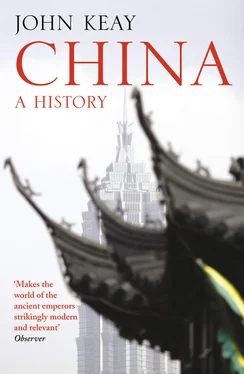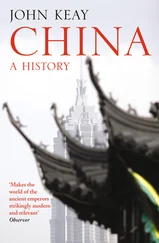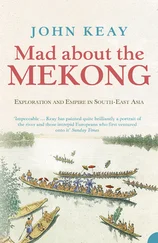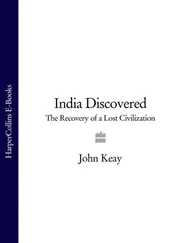West of Shanxi is the rather easily confused Shaanxi province (here denoting its position to the west of a district called Shaanzhou). All three provinces abut, or once abutted, the fickle Huang He (Yellow River). So too, fingering between Shandong and Shanxi, does the province of Hebei (‘River-north’, the river being the self-same Huang He). Naturally the province to the south of the river is therefore Henan (‘River-south’), although because the river has so often switched course, a bit of Henan is now on the north bank. These five northern provinces (Henan, Hebei, Shaanxi, Shanxi and Shandong) engross the entire extent of the rich alluvial plain of the lower Yellow River basin which, according to textual tradition, was where China’s earliest history was enacted. They have thus been traditionally regarded as the ‘cradle’ provinces of Chinese civilisation and were the focus of those mid-twentieth-century archaeologists.
South of Henan come more provincial twins. In the case of Hubei and Hunan, the Hu- denotes the great ‘lake’, or ‘lakes’ into which the lower Yangzi spills before meandering on to the coast. These two provinces therefore lie respectively north and south of the great lakes and so, roughly, north and south of the Yangzi itself. South again, and completing this spine of ‘core’ China come Guangdong and Guangxi. Guang means something like ‘enlarged (southern) territory’. These two once ‘enlarged’ provinces in the extreme south thus lie respectively east ( dong ) and west ( -xi ) of one another. Beyond them in the South China Sea, the island province of Hainan is the country’s southernmost extremity.
Returning north towards the Shandong peninsula by way of the coast, the provinces of Fujian, Zhejiang and Jiangsu plus adjacent Jiangxi and Anhui are smaller, and their names are not so obviously derived from compass bearings. Some contain directional elements, but most have been formed by combining the names of two of their more important centres. Thus Fujian combines Fu zhou, its port-capital, with Jian ning, a city at Fujian’s inland extremity. 9The -zhou ending, incidentally, once indicated an ‘island’ of ‘Chinese’ settlement in what was otherwise a still unacculturated region; it then came to denote the district that pertained to it, and now more commonly the principal city of the region. This same -zhou was once rendered in English as -chow or -choo ; hence nineteenth-century toponyms like ‘Foochow’ (Fuzhou), ‘Soochow’ (Suzhou), ‘Hangchow’ (Hangzhou), etc. More obviously, ‘Beijing’ (Peking, Pekin, etc.), the national metropolis within Hebei province, translates as ‘north-capital’, and Nanjing (Nanking), on the Yangzi in Jiangsu province, as ‘south-capital’ – which until 1937 it was.
All the provinces mentioned so far, plus those of Guizhou in the southwest and Sichuan, a vast region comprising most of the upper Yangzi basin, are sometimes said to constitute central, inner or ‘core’ China. Terms like ‘central’ and ‘inner’ are highly controversial, no distinction between centre and periphery, or inner and outer China, being either physically convincing, historically consistent or politically acceptable. It may, though, be helpful to adopt this phrasing to distinguish the seventeen productive, populous and long-integrated ‘core’ provinces, which have already been mentioned, from the traditionally less productive, less populous and less historically integrated provinces lying at the extremities of modern China.
Into this latter category fall the remaining eleven provinces, many of them large territories of sharp contrasts and emotive repute. Taiwan, a long island off the coast of Fujian, was once known to Europeans as Formosa. It was subsequently alienated from the mainland by Japanese occupation in the first half of the twentieth century and Nationalist occupation in the second half. About as far from Taiwan as Texas is from Florida, Yunnan in the south-west has also had a chequered relationship with the rest of the country. Straddling the climatic divide between torrid South-East Asia and arid central Asia, its forests are frequented by the odd elephant while yak grunt across its high passes. Farther north and west, the howling wastes and azure skies are those of Qinghai and Xizang, which together comprised the vast plateau region once vaguely known to non-Chinese as Tibet. Today Tibet is usually identified just with Xizang. North and west again, all that remains is Xinjiang. Largely desert though far from deserted, this is the largest of all China’s provinces and the remotest. It was once known to the Chinese as ‘the Western Regions’ and to non-Chinese as Eastern or Chinese Turkestan. The current designation simply means ‘the New Territories’ ( Xin-jiang ); indigenous activists would prefer ‘Uighuristan’, they being largely Muslim, Turkic-speaking Uighurs.
Returning east along China’s northern perimeter, elongated Gansu province and diminutive Ningxia province offer oasis-dotted access routes from the ‘core’ provinces into Xinjiang and Mongolia respectively. Sandwiched between the swamps of Qinghai and the sands of the Gobi, the east–west ‘Gansu corridor’ has become as much a cliché in Chinese history-writing as ‘the Tibetan plateau’. Ningxia, with a north–south axis, is strung along the upper reaches of the Yellow River and juts into the neighbouring province of Nei Monggol, otherwise Inner Mongolia. Although Outer, or northern, Mongolia is not part of today’s China, its border bisects the Gobi desert in a long east–west arc that leaves all to the south of it as a Chinese province. The sand and steppe of this Nei Monggol thus serves as a glacis to those several sections of ‘long wall’ that have been conflated into the Great Wall. Nei Monggol’s northern perimeter is China’s longest international frontier, and its southern perimeter marches with no less than eight other provinces – Gansu, Ningxia, Shaanxi, Shanxi, Hebei and the three provinces of erstwhile Manchuria.
These last, in the north-eastern appendage that used to be called Manchuria – or by the Japanese ‘Manchukuo’ – are all named after rivers. Heilongjiang, the most northerly province, is also the Chinese name for the Amur river; the Sino-Russian border here follows its course. Jilin province to the south derives from the Manchurian word for ‘alongside (the Songhua River)’; it marches with North Korea. And Liaoning, to the south-west, is named for the Liao River; it adjoins Hebei province and extends to within 300 kilometres (185 miles) of Beijing; south across the gulf of Bohai, Liaoning faces Shandong’s peninsula.
So ends the circuit of the eleven peripheral provinces, within which lie the seventeen core provinces, of which the five most northerly comprise the ‘cradle’ provinces. The administrative patchwork is completed by various smaller entities, such as the municipalities of Beijing and Shanghai and the special-status enclaves of Hong Kong and Macao. Numerous other autonomous entities based on ethnic minority concentrations should also be mentioned; these may be autonomous districts within the provinces, or autonomous regions comprising a whole province, such as Xizang/ Tibet.
Admittedly, there are more scientific ways of deconstructing China’s geography. In a continental landmass roughly the size of the United States and located within approximately the same degrees of latitude (the Tropic of Cancer, which grazes the Florida Keys, shaves southern China), much the same physical variations may be found. Extremes of climate and altitude result in wildly different average rainfalls, in soil conditions that range from swamp to sand dune and steppe, and in vegetational cover that runs from the riotous to the non-existent.
Читать дальше












